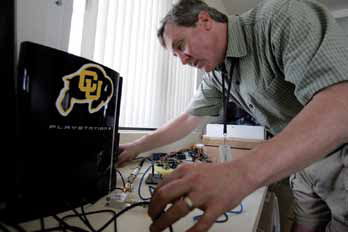
CIRES Christopher Williams aims to improve understanding, prediction of precipitation

Christopher Williams works on the prototype of his inexpensive vertical-profiling radar. The system uses a Sony PlayStation to process information captured by a set of three, $200 radar dishes.
state, letting water-rich clouds travel over the Sierra Nevada into Nevada before dropping their rain, and leaving California with less.
Williams suspects the story is more complicated. He and colleagues in NOAA’s Earth System Research Laboratory, the Scripps Institution of Oceanography, and the University of California in San Diego, hope to have a clearer picture of the relationship between air quality and water resources within five years. They’re setting up sophisticated instruments across California to determine how and when precipitation is affected by aerosols and other factors, such as atmospheric rivers and barrier jets.
Williams is also building a prototype dual-frequency, vertical profiling radar for less than $20,000 (one-tenth the cost of offthe- shelf commercial units), to feed demand in the weather and climate research community for affordable, sophisticated instruments to study precipitating clouds. Improved ground measurements of precipitating systems would help address regional questions such as those of concern in California, Williams said, and could also help calibrate rainfall measured by satellite.![]()
then uses “upscaling” techniques to more accurately depict regional and global processes.
Today, Williams is working on two key projects to improve scientific understanding and prediction of “precipitating cloud systems”—a study in California to determine the effect of air pollution, such as aerosols, on water resources there, and the development of an inexpensive radar system, which could be deployed widely to improve forecasting, especially around airports.
Aerosols can increase the number of small drops of moisture in clouds, Williams said, and in some cases, tinier drops mean precipitation may take longer to form and fall. In California, that has led some researchers to conclude that air pollution has changed the pattern of rainfall in the
Rain affects every aspect of human life, from agriculture to recreation, but it’s difficult to get it right in weather forecast and climate models. Several fundamentally different processes can pour rain or snow to the ground, and it’s not always clear which process is at work. Storms still slip through weather radars, causing unexpected havoc, and air pollution can complicate the picture further, by affecting cloud and rainfall physics.
It is this complexity that draws CIRES’ Christopher Williams to study the dynamics of rainfall. “Think about rain falling on a lake,” Williams said. “It’s not at all uniform. You see these cat paw patterns...” Scientists may not hope to reproduce such small-scale patterns in computer models, but it is possible to improve the way the models represent rainfall. Williams analyzes small-scale observations and


